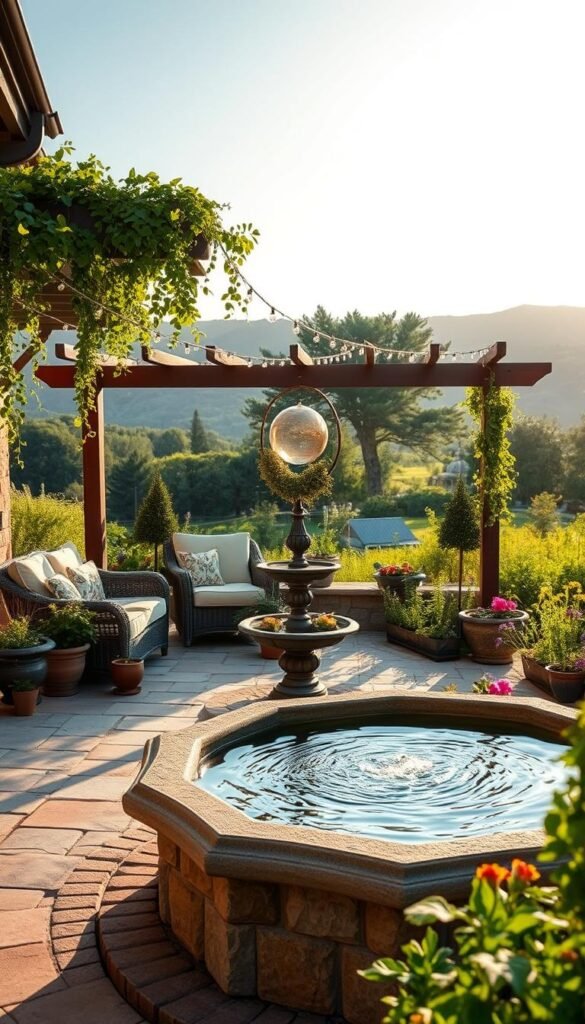Your backyard holds endless potential to become a personal sanctuary that blends comfort with nature. Modern outdoor living areas now act as natural extensions of your home, offering flexible spaces for everything from morning coffee to weekend gatherings. Whether you have a sprawling lawn or a compact balcony, thoughtful design can turn any area into a functional escape.
Great space planning starts by balancing beauty and practicality. Imagine a cozy corner for reading surrounded by fragrant herbs, or a dining zone that transitions seamlessly from indoor meals to starlit dinners. These elements don’t just look inviting – they create lasting memories while boosting your property’s appeal.
You’ll discover how simple updates like strategic lighting or multi-level planters can redefine your experience. The best part? Most transformations require creativity more than big budgets. We’ll walk through proven strategies that work for various layouts and lifestyles.
By blending expert tips with real-world examples, this guide helps you craft an environment that feels uniquely yours. Let’s explore how to maximize every square foot while keeping maintenance manageable. Your dream escape awaits!
Transform Your Outdoor Space into a Relaxing Oasis
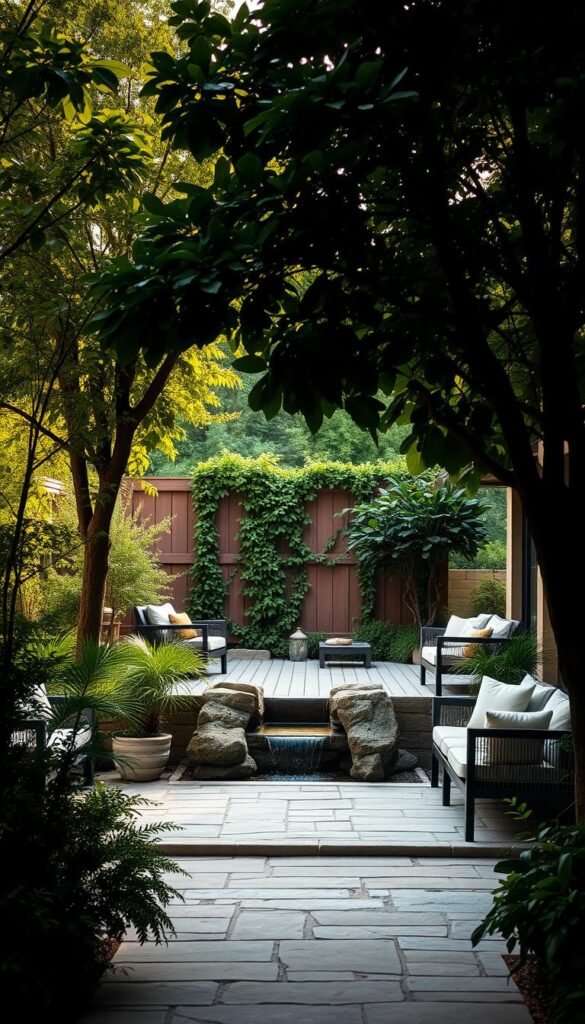
Imagine stepping outside to a personalized retreat where every element aligns with your daily rhythm. Start by evaluating how you’ll use your area—do you crave quiet mornings with coffee or lively dinners under string lights? Mapping out these needs helps shape a design that feels both intentional and effortless.
Think about how sunlight moves across your patio or where shadows linger during summer afternoons. These details determine where to place seating, planters, or shade solutions. As one landscape architect notes:
“The best layouts work with nature, not against it.”
Balance beauty and function by choosing materials that withstand weather while complementing your home’s style. For example, weather-resistant wicker chairs paired with vibrant cushions add comfort without sacrificing durability. If gardening sparks joy, consider elevating your space with a gardening through vertical planters or herb borders.
Don’t forget multi-season flexibility. A fire pit extends evenings into cooler months, while retractable awnings offer summer shade. By planning for year-round use, your oasis stays relevant through every season.
Finally, mirror indoor comforts outside. Soft rugs, layered lighting, and cohesive color palettes create continuity between rooms. This approach makes your entire property feel unified—a true extension of your living area.
Embrace the Essence of 8 Patio Garden Ideas for Relaxing Outdoor Living
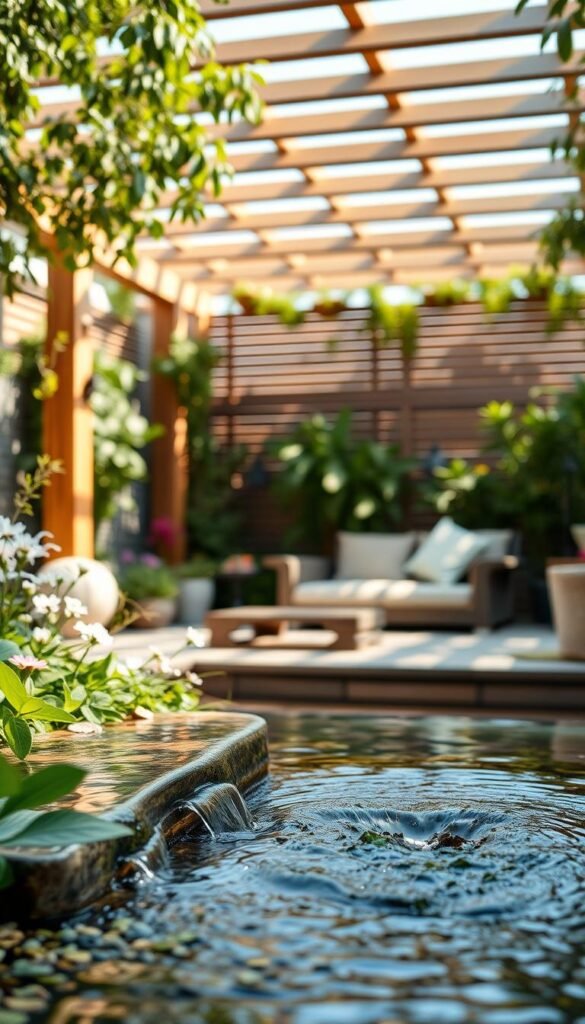
Great outdoor areas blend purpose with beauty, acting as natural extensions of your home. Modern design principles focus on clean lines and nature-inspired layouts. These ideas help create zones that feel intentional yet inviting.
Think of your space as a series of “rooms” with distinct functions. A dining nook might flow into a lounging corner, connected by shared colors or materials. This approach keeps the area cohesive while serving multiple needs. For maximizing compact areas, vertical planters or foldable furniture work wonders.
Scale matters when arranging elements. A tiny bistro table suits a balcony better than a bulky sectional. Landscape designer Mara Santos notes:
“Balance comes from matching proportions to your available square footage—every piece should earn its place.”
Your personal style shines through material choices and decor. Rustic wood accents suggest farmhouse charm, while sleek metal planters lean modern. The cottagecore aesthetic proves how whimsical touches can transform ordinary yards.
| Design Approach | Key Elements | Best For |
|---|---|---|
| Minimalist | Geometric planters, neutral tones | Urban settings |
| Bohemian | Patterned textiles, mixed textures | Creative spaces |
| Transitional | Weather-resistant wicker, evergreens | Year-round use |
Layering transforms basic setups into rich environments. Start with foundational pieces like pavers or decking. Add greenery for softness, then lighting for evening charm. Finally, accessories like outdoor rugs tie everything together.
Designing Zones for Dining, Lounging, and Entertaining
What if your backyard could host dinner parties and quiet evenings with equal ease? Smart zoning turns your patio into a versatile stage for daily life. Start by mapping how you’ll use your space – weekly barbecues or sunset yoga sessions shape your layout.
Creating Distinct Functional Areas
Define zones using furniture clusters and decor accents. A dining spot might feature a weatherproof table with bold placemats, while a lounging nook uses deep-seated chairs around a fire bowl. Designer Elena Torres suggests:
“Anchor each zone with a focal point – like a planter wall behind seating or pendant lights above a table.”
| Zoning Technique | Key Elements | Benefits |
|---|---|---|
| Furniture Grouping | Sectionals, side tables | Encourages conversation |
| Flooring Changes | Deck tiles vs. gravel | Visual separation |
| Vertical Planters | Herb walls, trellises | Space-saving privacy |
Setting Up Multi-Use Spaces
Choose pieces that pull double duty. Nesting tables tuck under benches by day, then expand for game nights. Storage ottomans offer seating while hiding blankets or grill tools. For unique ways to decorate, try hanging lanterns that illuminate dining areas and cast cozy patterns on lounge zones.
Keep pathways at least 3 feet wide between zones – wide enough for serving trays but narrow enough to feel intimate. Use low-growing herbs as natural dividers that scent the air when brushed against.
Incorporating Stylish Furniture and Cozy Seating
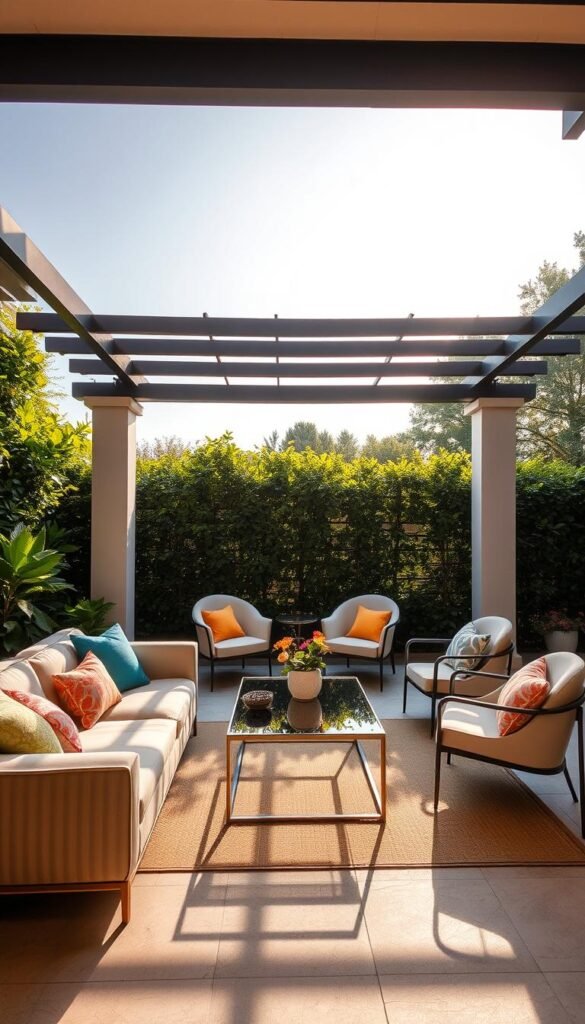
The right furniture transforms your patio from blank canvas to curated retreat. Focus on pieces that balance weather resistance with plush textures, creating spaces where guests linger effortlessly.
Choosing the Right Outdoor Pieces
Measure your area before selecting items – oversized sectionals overwhelm small spaces, while petite bistro sets get lost in large yards. Opt for materials like powder-coated aluminum or teak that resist fading. As designer Clara Mendez advises:
“Treat outdoor seating like indoor decor – layer cushions in varying thicknesses for hotel-lounge comfort.”
| Material | Lifespan | Maintenance |
|---|---|---|
| Synthetic Wicker | 5-8 years | Wipe monthly |
| Cedar Wood | 10-15 years | Annual sealing |
| Cast Aluminum | 20+ years | Occasional wash |
Integrating Built-in Benches and Statement Chairs
Built-in seating maximizes awkward corners while adding architectural interest. Flank a fire pit with curved benches, or create window-box style planters with hinged lids for hidden storage. Complement these with eye-catching chairs like egg-shaped rattan swings or leather-accented Adirondacks.
Mix permanent and movable elements – a fixed bench paired with lightweight side tables adapts to different gatherings. This approach maintains flexibility while establishing visual anchors in your layout.
Creating Privacy with Plants and Natural Barriers
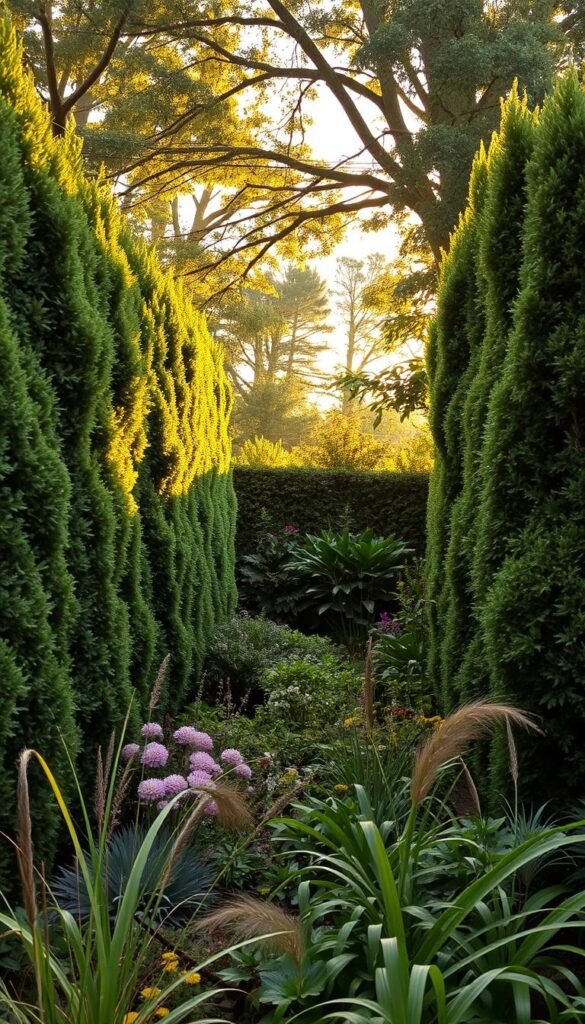
Crafting a private retreat doesn’t require towering fences or bulky walls. With clever plant choices, you can shape your space into a serene escape that feels connected to nature. Start by selecting greenery that matches your climate and design goals – fast-growing options like bamboo work wonders in tight urban areas.
Boxwood hedges offer classic structure, while ornamental grasses add movement and texture. For vertical interest, pair climbing vines with decorative metal screens. These combos filter light and noise without blocking breezes. As landscape designer Jamie Carter notes:
“Layered plantings create depth – place taller species behind low-growing herbs to guide sightlines.”
| Plant Type | Growth Speed | Best Use | Maintenance |
|---|---|---|---|
| Bamboo | Fast | Space dividers | Annual root pruning |
| Boxwood | Moderate | Formal borders | Seasonal trimming |
| Climbing Ivy | Rapid | Screen coverage | Monthly guidance |
Position plants to block unwanted views while preserving desirable sightlines. A staggered row of arborvitae along your patio edge shields seating areas but keeps skies visible. For multi-season appeal, mix evergreens with flowering shrubs like hydrangeas.
Remember to consider your local climate when choosing species. Drought-tolerant grasses thrive in sunny spots, while ferns prefer shaded corners. Many budget-friendly gardening solutions use native plants that adapt easily to regional conditions.
These living barriers do more than hide neighbors – they attract pollinators and soften hard exterior surfaces. With strategic placement, your sanctuary stays airy yet intimate, proving functionality and beauty grow well together.
Setting the Mood with Lighting and Ambience
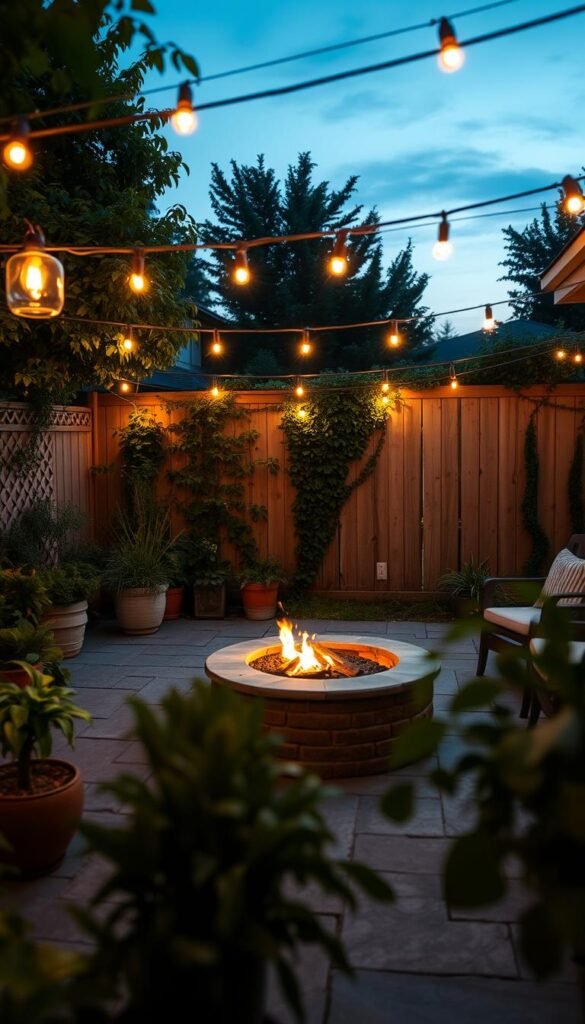
Lighting shapes how you experience your evenings outdoors, turning simple spaces into magical retreats. Strategic placement goes beyond visibility—it crafts atmosphere. Whether hosting friends or unwinding solo, the right glow elevates every moment after sunset.
Harnessing Soft Glows & Tech Solutions
String lights remain a favorite for their versatility. Drape them overhead for starry-night effects or wrap tree trunks for woodland charm. Designer Lila Nguyen suggests:
“Mix bulb sizes – large globes make bold statements, while mini LEDs add subtle sparkle without overwhelming.”
Smart systems take convenience further. Adjust brightness via phone apps or schedule lights to mimic sunset hues. This tech lets you switch between vibrant dinner parties and relaxed reading nights instantly.
| Light Type | Best Use | Energy Efficiency |
|---|---|---|
| Edison Bulbs | Rustic charm | Moderate |
| Solar LEDs | Pathways | High |
| Color-Changing | Theme nights | Varies |
Warmth That Draws People Together
A fire pit does double duty – it provides flickering light and becomes your gathering hub. Opt for smokeless bioethanol models for cleaner burns or portable designs for flexibility. Surround seating with heat-resistant materials like slate or concrete.
For cooler evenings, pair flames with plush throws and stone seating that retains warmth. This combo keeps your patio inviting long after summer fades, proving functionality and ambiance aren’t mutually exclusive.
Maximizing Small Patio Spaces with Clever Design
Compact outdoor areas challenge you to think creatively about every inch. New York architect Kevin Lichten advises:
“Treat patios as outdoor rooms – proper scale and material choices define their success.”
This approach turns tight quarters into inviting extensions of your home.
Start by selecting furniture that serves multiple purposes. A storage bench holds cushions while doubling as seating. Nesting tables tuck neatly under chairs when unused, then expand for drinks or snacks. For patio container gardening, use wall-mounted planters to keep floors clear.
| Furniture Type | Space-Saving Feature | Ideal Use |
|---|---|---|
| Folding Bistro Set | Collapses to 12″ depth | Balcony breakfasts |
| Stackable Stools | Vertical storage | Extra seating |
| L-shaped Bench | Fits corners | Dining & lounging |
Vertical elements trick the eye upward. Hang pendant lights above a compact dining set to draw attention higher. Tall, narrow planters add greenery without eating into walkways. Mirrors placed strategically reflect light and views, making spaces feel airier.
Limit your color palette to three tones for visual cohesion. Light-colored cushions blend with walls, while bold throw pillows add personality. Keep pathways at least 30 inches wide – enough for movement but cozy enough for conversation.
Edit ruthlessly. Choose three core activities your area must support, then build around those. A reading nook needs just a chair and side table, while an entertainment zone focuses on flexible seating. By prioritizing function, your small patio becomes a tailored retreat rather than a catch-all space.
The Impact of Hardscaping and Outdoor Rugs
The foundation of your retreat lies in materials that balance beauty with resilience. Hardscaping sets the tone, while rugs add warmth and define zones. Together, they create a polished design that handles whatever Mother Nature delivers.
Selecting Durable Materials for All-Weather Use
Choose surfaces like stamped concrete or natural stone for your patio – they withstand heavy foot traffic and seasonal shifts. For weather-proof textiles, polypropylene rugs resist fading and mold. As designer Marco Perez advises:
“Prioritize texture over trends – woven patterns hide dirt better than solid colors.”
Anchoring your rug with furniture prevents tripping and adds stability during windy days. Complement these elements with composite decking that mimics wood without constant sealing. This approach maximizes your space while keeping maintenance minimal.
Remember: cohesive materials unify your patio’s look. Match your rug’s hues to nearby planters or pavers for a pulled-together feel. With smart choices, your setup stays inviting through every weather twist.

